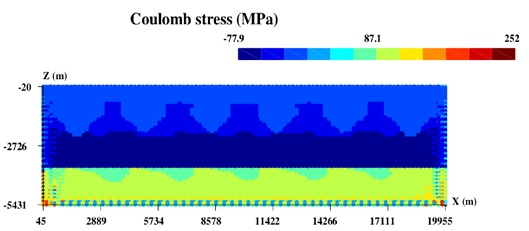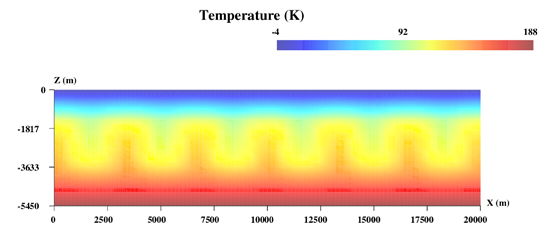Step by Step
After selecting a catalog in the User's workspace, click on 'ACTIONS', then 'USE IN APPLICATION' and then 'Stress and strain changes induced by fluid injection and temperature change driven by geothermal injection'
- Parameters values and options, have to be requested to be fulfilled
- After choosing all the aforementioned parameters the User may click on 'RUN' button to proceed to the calculation process. The results are soon to be available and saved by the system. As outputs, the THM model allows to obtain: (i) temperaturedepth profiles can be obtained in both format .png and .eps ; (ii) the spatial distribution of the temperatures in format .pos (visualized by gmsh) and .pdf ; (iii) the spatial distribution of the Coulomb stress in format . pos (visualized by gmsh) and .pdf.
Input Parameters
Number and width of the horizontal homogenized layers
We define the homogenized layers composing the reservoir. The first layer defined would be the shallowest one and the last the deepest one. The number and the width of the consecutive layers are parameters.
Rock properties for each horizontal layer
For each layer, are defined petrophysical properties homogenized at the scale of the Representative Elementary Volume. References values are put by default and a certain range of values is authorized for each property. The set of properties includes the: (i) porosity, (ii) permeability, (iii) thermal dilation, (iv) heat capacity, (v) thermal conductivity and (vi) density. Elastic moduli such as the Young's modulus and the Poisson's ratio are also taken into account in the THM model. To be noted, an unrealistic permeability higher than 1e-14 m² can lead to a divergence of the calculation.
Numerical parameters
The vertical spatial discretization for each layer can be parametrized. The geometrical properties such as the width (i. e. the sum of the layer lengths) and length are also free parameters. The temporal discretization of the calculation is taken as an input. Finally, the pressure and temperature are set on the surface and on the reservoir bottom as boundary conditions in the THM model. The surface is considered as a free surface. More details in the references Vallier et al. , (2018) and Vallier et al. , (2019).
More advanced parameters
The parameterization of the convergence criterion to reach the stationary state is set as an advanced level.
Results

Figure 1 : Spatial distribution of Coulomb stress in the reservoir

Figure 2 : Spatial distribution of temperature in the reservoir

Figure 3 : Vertical profiles temperature-depth for different lateral positions

